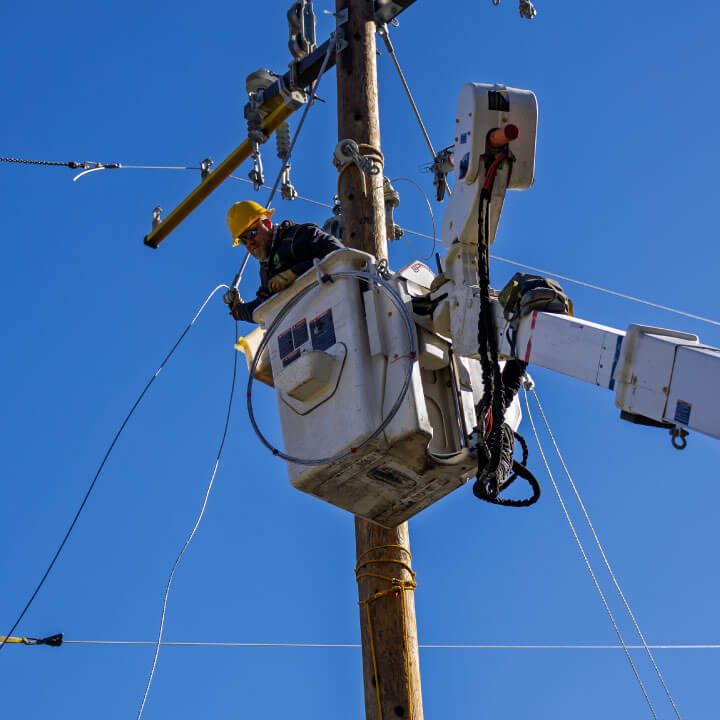When time allows, we’re proud to offer engaging high-voltage safety demonstrations for schools, first responders, and community organizations,
We love sharing our expertise with the community. But because our first priority is keeping the lights on, these opportunities depend on staff time, scheduling availability, and fit for the audience.
If your group is interested, fill out the form below and a member of our team will connect with you to explore what’s possible.
Additional resources courtesy of the Electrical Safety Foundation and National Fire Protection Association.

It was exciting when Ben Franklin flew his kite and key into a lightning storm, but definitely dangerous. In the century since electricity has become ubiquitous in America, it’s also much safer for us to harness and use it. But it still comes with real risk. According to the Electrical Safety Foundation, home electrical fires and accidents critically injure thousands of people in the United States and cause more than $1.3 billion in property damage each year. In our modern world, you have the power to protect your family and your home from electrical accidents.
Electricity is essential to our economy and our workplaces, but it’s not without risk to employees. Adults are more likely to experience electrical accidents and injuries at work than at home. Certain professional environments come with greater risk. Often, it’s lack of awareness or training that leads to harm. Prevention really is the best medicine.
Colorado’s storms are as magnificent as her mountains—and deserve as much respect. Severe storms and their aftermath can trigger fires, flooding, mudslides, and power outages. The resulting electrical hazards can cause serious injury or even death. Every season has its scourge, from ice to wind to water to lightning. Like venturing into our mountains, a good offense is the best defense.
Have a backup generator or battery source, such as a Tesla Powerwall installed and charged for emergencies. Many of the fatalities associated with generator use happen during or just after storms, so know the safety protocols for use before, during, and after severe weather conditions. Safe use saves lives.
Make sure your generator has a transfer switch to prevent backfeeding. Backfeeding can be deadly, including harming utility workers making repairs. Transfer switches keep everyone safe, plus they can prevent electrical fires caused by short circuits and improper connections.
Lightning is exciting—and can be deadly. And not just on mountaintops: 1/3 of lightning-related injuries happen inside your home. A few simple lightning precautions make a world of difference in how you fare when the sky comes alive in bolts and jolts.
Whether sparked by nature or humans or both, fires are no stranger in Colorado. Summer storms may ignite wildfire, but luminant human holidays such as Fourth of July, Halloween and Christmas can kindle home fires. Fire can cause real and far-reaching devastation, so stay safe with fire preparedness and risk management awareness.
Floods cause more deaths each year than any other severe weather-related hazard and they can happen anywhere. Water and electricity are a recipe for disaster so reduce your risks with proven flood safety protocols.
Winter storms can spark electrical hazards. Safely navigate downed power lines, portable generators, and supplemental heat sources with these winter storm safety tips.
Storms can cause electric voltage to drop from its usual level. These voltage drops, called brownouts, can damage your home’s electronics, including unexpected electronic failure in the future. A sustained brownout could damage electronic motors in washing machines, dryers, fans, air conditioners, refrigerators, and freezers. Protect your electronics from brownouts with uninterruptible power supplies, energy storage systems, smart meters, generators and surge protectors.
You want to spark your kid’s curiosity—just not literally. Most electrical injuries in children 12 and under are caused by low-voltage electricity delivered through household appliance electrical cords, extension cords, and wall outlets. A few precautions coupled with basic electrical education help keep kids safe from electrical accidents without quelling their curiosity.
Teach your kids about electricity, its potential dangers, and where they’ll find these dangers in and around your home.
Be aware and share electrical safety with your kids.
Ensure all wires are properly insulated and tucked away from your child’s reach.
Supervise children anywhere near potential electrical hazards.
Keep small appliances away from water, including bathtubs or pools.
Make learning about electricity and electric safety fun with ESFI’s kids’ corner games and cartoons.
Additional resources courtesy of the Electrical Safety Foundation.
Working on roofs, installing gutters, painting exteriors, or hanging holiday lights can put you dangerously close to energized power lines. Keep yourself and your crew safe by following these tips to avoid potentially deadly electrical contact.
Before starting any job, take a moment to look around your work area. Identify any overhead power lines, poles, or guy wires, and make sure everyone on your crew knows where they are.
Always check for power lines before raising ladders, tools, or materials, and when setting up or moving scaffolding.
Stay at least 20 feet away from overhead power lines carrying up to 50 kV. Higher voltages require even more distance.
If your equipment touches a power line or causes one to fall:
